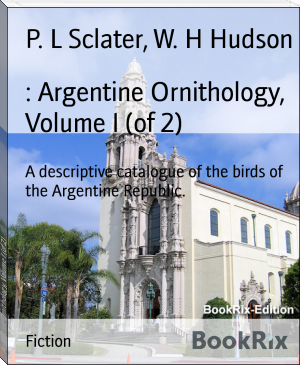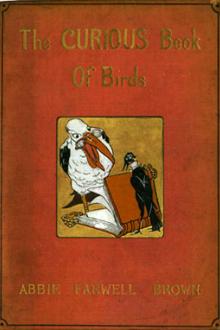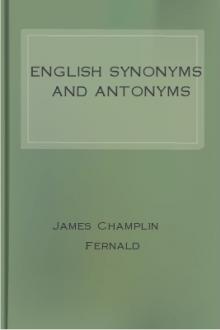: Argentine Ornithology, Volume I (of 2), P. L Sclater, W. H Hudson [best authors to read txt] 📗

- Author: P. L Sclater, W. H Hudson
Book online «: Argentine Ornithology, Volume I (of 2), P. L Sclater, W. H Hudson [best authors to read txt] 📗». Author P. L Sclater, W. H Hudson
like that of a cicada than of a bird. This piercing torrent of sound is
broken at intervals by a long grave note, or half a dozen short rapid
notes in a lower key, which come as an agreeable relief.
In towns they build in walls, like the English Sparrow; in country
places they always select the domed nest of some Dendrocolaptine species
to breed in. Possibly in some districts where I have not been, this
Sparrow selects other breeding-sites; my experience is that outside of
a town it never lays anywhere but in some domed nest, and at home I
frequently put up boxes for them in the trees, but they would not notice
them, though the Wrens and Swallows were glad to have them. Sometimes
they make choice of the large fabric of the _Anumbius acuticaudatus_,
called Leñatero in the vernacular; but their claim to this nest (even
when the Leñateros are out of it) is frequently disputed by other
species which possess the same habit as this Sparrow, but are more
powerful than he. Their favourite breeding-place is, however, the solid
earthen structure of the Oven-bird; and it is wonderful to see how
persistently and systematically they labour to drive out the lawful
owners--birds so much larger and more powerful than themselves. Early in
spring, and before the advent of the Tree-Martins, the pair of Sparrows
begin haunting the neighbourhood of the oven they have elected to take
possession of, usually one pretty high up in a tree. As the season
advances their desire towards it increases, and they take up their
position on the very tree it is in; and finally a particular branch
near the oven, commanding a good view of the entrance, is chosen for a
permanent resting-place. Here they spend a great portion of their
time in song, twitterings, and loving dalliance, and, if attentively
observed, they are seen with eyes ever fixed on the coveted abode. As
the need for a receptacle for the eggs becomes more urgent they grow
bolder, and in the absence of the owners flit about the oven, alight
on it, and even enter it. The Oven-bird appears to drive them off with
screams of indignation, but the moment he retires they are about it
again, and, even when it contains eggs or young birds, begin impudently
carrying in feathers, straws, and other materials for a nest, as if they
were already in undisputed possession. At this stage the Tree-Martins
(_Progne tapera_) perhaps appear to complicate matters; and even if
these last comers do not succeed in ousting the Oven-birds, they are
sure to seize the oven when it becomes vacant, and the Sparrows, in
spite of their earlier claim, are left out in the cold. But they do not
take their defeat quietly, or, rather, they do not know when they are
beaten, but still remain to harrass their fellow-pirates, just as they
did the Oven-birds before, bringing straws and feathers in their
beaks, and when forced to drop these materials and chased from the
neighbourhood with great noise and fury by the Tree-Martins, it is only
to return undaunted in a few minutes, bringing more straws and feathers.
This Sparrow makes a rather large nest, neatly lined with horsehair,
and lays five eggs, long, pointed, the entire surface thickly marked
with deep chocolate-brown.
In rural districts this species is comparatively rare, not more than one
or two couples being seen about each habitation; and I scarcely think it
would be too much to say that there are four or five thousand Chingolos
for every individual Yellow Sparrow. Yet it is a hardy little bird, well
able to hold its own, subsists on the same kind of food and lays as many
eggs as the _Zonotrichia_; and it possesses, moreover, a great advantage
over the dominant species in placing its nest out of the reach of the
parasitical _Molothrus_, the destroyer of about fifty per cent. of the
Chingolo's eggs. I can only attribute the great disparity in the numbers
of the two species to the fact that the Yellow House-Sparrow will breed
only (out of towns) in nests not easily taken, and to the stubborn
pertinacity which leads it to waste the season in these vain efforts,
while the other species is rearing its brood. This is a blunder of
instinct comparable to that of the Minera (_Geositta cunicularia_),
mentioned by Darwin in the 'Voyage of a Naturalist,' where the bird made
its hole in a mud wall a few inches wide, and on coming out on the other
side simply went back and made another hole, and then another, unable to
understand that the wall had not the requisite width.
In such a case as the Yellow House-Sparrow presents, in which the colour
of the sexes differs, the female being without any of the brighter
hues found in the male, and which makes an elaborate nest and lays
deeply-coloured eggs, it is impossible not to believe that the bird
originally built in exposed situations, and subsequently--perhaps in
very recent times--acquired the habit of breeding in dark holes. The
frequent destruction of the exposed nest, and an abundance of vacant
domed nests, into which some individuals occasionally penetrated to
breed, would lead to the acquisition of such a nesting-habit; for the
birds inheriting it would have an advantage and be preserved, while
those persisting in the old habit of building exposed nests would
perish. Domed nests made by Dendrocolaptine birds are very abundant
even now, and it is probable that, before the country became settled by
Europeans, they were very much more numerous. Darwin, speaking of the
Oven-bird's habit of always placing its oven in the most conspicuous and
(to man) accessible places, predicts, and truly I believe, that this
habit will eventually cause the extinction of the species; for when the
country becomes more thickly settled, the bird-nesting boys will destroy
all the ovens. Probably when the Oven-birds were more abundant the
Sparrows could always find vacant ovens to breed in, until a habit of
breeding almost exclusively in these safe and convenient bird-built
houses was acquired; and the present seemingly stupid persistence of
the birds in struggling to get possession of those already occupied by
stronger species, only shows that the habit or instinct has not been
modified to suit a change in the conditions--_i. e._ a diminishing
number of ovens to breed in, with, perhaps, the increase of other
stronger species possessing the same habit. But while the instinct thus
survives too strongly in the country birds, many individuals have taken
to a town life, and acquired the new habit of breeding in holes in brick
walls. Probably this race of town birds will eventually colonize the
rural districts, and usurp the place of the country birds, which will
then be placed at a disadvantage.
90. SYCALIS LUTEA (d'Orb. et Lafr.). (YELLOW SEED-FINCH.)
+Sycalis chloropis+, _Burm. La-Plata Reise_, ii. p. 489 (Mendoza and
Catamarca), +Sycalis lutea+, _Scl. Ibis_, 1872, p. 46, pl. ii.
fig. 2.
_Description._--Dark yellow; rump and body below brighter; wings
and tail brownish black, edged with yellow; under wing-coverts pale
yellow; inner margins of wing-feathers pale brown: whole length 5·5
inches, wing 3·2, tail 2·1. _Female_ similar, but duller and more
brownish.
_Hab._ Andes of Peru, Bolivia, and Argentina.
Prof. Burmeister obtained examples of this species near Mendoza. In my
revision of the genus published in 1872, I referred the specimens (upon
some of which Prof. Burmeister based his species _S. chloropis_) to _S.
uropygialis_. I now find that this was an error, and that they really
belong to _S. lutea_.--P. L. S.
91. SYCALIS LUTEOLA (Sparrm.). (MISTO SEED-FINCH.)+Sycalis luteola+, _Scl. Ibis_, 1872, p. 44; _Scl. et Salv. Nomencl._
85; _Durnford, Ibis_, 1877, p. 172 (Buenos Ayres), et 1878, p.394 (Centr. Pat.); _Barrows, Bull. Nutt. Orn. Cl._ viii. p. 132
(Entrerios). +Sycalis luteiventris+, _Burm. La-Plata Reise_, ii.
489.
_Description._--Above light olive-green, marked with dusky stripes;
wing-feathers blackish, with pale brownish edges; tail-feathers the
same; beneath, throat and chest dusky buff, lower breast and belly
yellow; bill and feet horn-colour; total length 5·0 inches, wing
2·6, tail 2·0. _Female_ similar, but not so bright.
_Hab._ S. America, from Colombia to Chili.
This is a slender, graceful bird, less than the Canary in size, the
whole upper plumage yellowish olive, with dun markings, the lower
surface of a dull yellow. The female is a little smaller than the male,
and her colours are somewhat dimmer.
This species is resident and gregarious in the Argentine Republic,
and in autumn frequently congregates in flocks of several thousands.
They are not so universally distributed as the Chingolo, and are not
wood-birds, but frequent open plains abounding in thistles and other
coarse herbage, which affords them shelter. In cultivated districts,
where their food is most abundant, they are excessively numerous, and,
after the harvest has been gathered, frequent the fields in immense
flocks. While feeding, the flocks scatter over a large area of ground,
being broken up into small companies of a dozen or more birds, and at
such times are so intent on their food that a person can walk about
amongst them without disturbing them. They take flight very suddenly,
bursting into a thousand chirping, scolding notes, pursue each other
through the air, and, after wheeling about the field for a minute or
two, suddenly drop down into the grass again and are silent as before.
In August they begin to sing, here and there an individual being heard
in the fields; but when the weather grows warmer they repair to the
plantations in vast numbers, and, sitting on the branches, sing in
a concert of innumerable voices, which produces a great volume of
confused sound, and which often continues for hours at a time without
intermission.
By-and-by these pleasant choirs break up, the birds all scattering over
the plains and fields to woo and build, and it is then first discovered
that the male has a peculiar and very sweet song. Apart from his
fellows, he acquires a different manner of singing, soaring up from
his stand on the summit of a bush or stalk, and beginning his song the
moment he quits his perch. Ascending, he utters a series of long,
melodious notes, not loud, but very distinctly enunciated and increasing
in volume; at a height of fifty or sixty yards he pauses, the notes
becoming slower; then, as he descends with a graceful spiral flight, the
wings outstretched and motionless, the notes also fall, becoming lower,
sweeter, and more impressive till he reaches the earth. After alighting
the song continues, the notes growing longer, thinner, and clearer,
until they dwindle to the merest threads of sound, and cease to be
audible except to a person standing within a few yards of the songster.
The song is quite unique in character, and its great charm is in its
gradual progress from the somewhat thick notes at the commencement to
the thin, tremulous tones with which the bird returns to earth, and
which change again to the excessively attenuated sounds at the end.
The nest is deep, well-built, and well-concealed, sometimes resting
on the ground, but frequently raised above it. It contains five long,
pointed eggs, with a white or bluish-white ground-colour, and thickly
spotted with brown. I have, frequently found the eggs of the _Molothrus_
in its nest, but have





Comments (0)